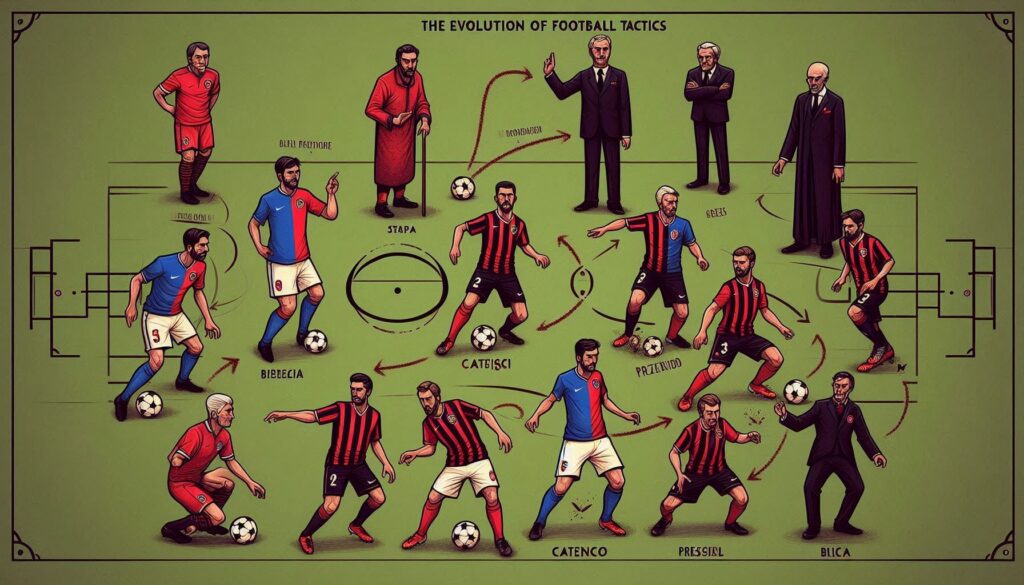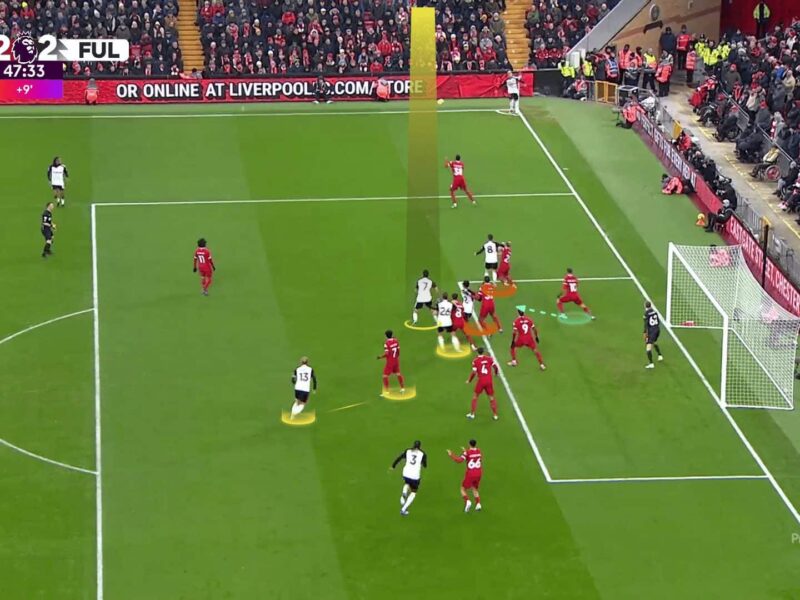Football, at its core, is a simple game: score more goals than your opponent. Yet, the methods employed to achieve this seemingly straightforward objective have undergone fascinating and complex transformations throughout history. Tactics are the hidden language of the pitch, dictating shape, movement, and philosophy. They are constantly evolving, reacting to previous innovations and anticipating future trends.

Let’s trace some of the major tactical shifts that have shaped the modern game:
The Early Days & The WM Formation (Pre-1950s)
Early football often featured incredibly attack-heavy formations like the 2-3-5 “Pyramid.” The game was less structured strategically. A major tactical shift came with Herbert Chapman’s Arsenal in the 1920s and 30s, popularizing the WM formation (3-2-2-3). This was a response to an offside rule change. By dropping the centre-half into defense and pulling back two inside forwards, it created more defensive solidity and structure, marking a move towards balance between attack and defense.
The Rise of Ultra-Defense: Catenaccio (1950s-1970s)
Emerging primarily in Italy, Catenaccio (meaning “door-bolt”) represented a philosophy prioritizing defensive security above all else.
- Core Principles: Highly organized defense, man-marking across the pitch, and crucially, the use of a “libero” or sweeper – a free defender positioned behind the main defensive line to sweep up any through balls and cover for marking errors.
- Strategy: Absorb pressure, frustrate opponents, win the ball back deep, and hit teams quickly on the counter-attack, often relying on individual brilliance upfront.
- Key Proponents: Nereo Rocco (AC Milan), Helenio Herrera (Inter Milan).
- Impact: Extremely successful, particularly for Italian clubs and the national team in the 60s. It became synonymous with disciplined, often cynical, defending aimed at protecting leads. While effective, it was often criticized for being negative and stifling attacking play.
The Dutch Revolution: Total Football (1970s)
As a direct antidote to the rigidity of Catenaccio and man-marking systems, the Netherlands, Ajax, and Barcelona (under Rinus Michels and Stefan Kovacs, starring Johan Cruyff) pioneered Total Football.
- Core Principles: Fluidity and interchangeability of positions. Any outfield player could theoretically take over the role of any other player in the team. High pressing to win the ball back quickly. Exploitation of space. Offside trap used aggressively.
- Strategy: Dominate possession, create overloads through intelligent movement and positional rotation, stretch the pitch, and disorient rigid defensive structures. Players needed high tactical intelligence, technical skill, and fitness.
- Key Proponents: Rinus Michels, Johan Cruyff (as player and later manager).
- Impact: Revolutionized attacking football. While demanding incredibly skilled and intelligent players, its principles – pressing, positional fluidity, importance of space – laid the groundwork for many modern attacking philosophies.
The Organized Press & Zonal Marking (Late 1980s – 1990s)
Arrigo Sacchi’s legendary AC Milan side refined pressing and defensive organization. While not abandoning man-marking entirely, the emphasis shifted towards zonal marking and collective movement.
- Core Principles: Compact team shape (short distance between defense and attack), a high defensive line to compress space, coordinated pressing triggers to win the ball in specific areas, and disciplined zonal coverage rather than purely following individual opponents.
- Strategy: Suffocate the opposition by denying them space and time on the ball, force turnovers in dangerous areas, and maintain a cohesive unit.
- Key Proponents: Arrigo Sacchi.
- Impact: Sacchi’s Milan dominated Europe and demonstrated the effectiveness of a highly organized, collective pressing system. Zonal marking became the dominant defensive strategy globally, forcing attackers to find new ways to break down organized blocks.
Possession Perfection: Tiki-Taka (Late 2000s – Early 2010s)
Building on the foundations of Total Football, Pep Guardiola’s Barcelona and the Spanish national team perfected a style known as Tiki-Taka.
- Core Principles: Extreme emphasis on short, intricate passing and maintaining possession. Constant movement to create passing triangles. Patience in build-up. Intense pressing immediately upon losing the ball (“six-second rule”). Positional discipline (“Juego de Posición”).
- Strategy: Dominate the ball to dominate the game. Starve the opposition of possession, pull them out of position through relentless passing, and create openings through quick combinations. Possession wasn’t just for attack; it was a form of defense.
- Key Proponents: Pep Guardiola, Vicente del Bosque.
- Impact: Achieved unprecedented success for Barcelona and Spain. Became hugely influential globally, though difficult to replicate without players of immense technical quality and tactical understanding. Eventually, teams developed counter-strategies (deep blocks, rapid counter-attacks).
The Age of Transition: Gegenpressing (2010s – Present)
Reacting partly to the dominance of possession football, a high-intensity style often associated with German coaches like Jürgen Klopp gained prominence: Gegenpressing (Counter-Pressing).
- Core Principles: Not just pressing, but pressing immediately (within seconds) after losing possession, ideally high up the pitch. The turnover itself is seen as the best moment to create a chance, catching the opponent disorganized as they transition from defense to attack.
- Strategy: Win the ball back as close to the opponent’s goal as possible. Use chaotic, high-energy transitions to create scoring opportunities quickly before the defense can reset. Requires incredible fitness and collective commitment.
- Key Proponents: Jürgen Klopp, Ralf Rangnick (influential theorist).
- Impact: Hugely successful for Klopp’s Dortmund and Liverpool. Emphasized the importance of transitions and athletic intensity. Many teams now incorporate elements of counter-pressing into their game, even if they don’t employ it as relentlessly.
The Modern Synthesis: Flexibility and Hybrids (Present Day)
Today’s top managers rarely adhere strictly to one single philosophy. Modern tactics are often hybrid approaches, blending elements from different eras:
- Positional Play (Pep’s Evolution): Still values possession but with more emphasis on verticality, creating superiority in specific zones, and using flexible player roles (like inverted fullbacks).
- Tactical Flexibility: Teams often switch formations and approaches multiple times within a single game based on the score, opponent, and game state.
- Data Analytics: Statistical analysis plays a huge role in identifying opponent weaknesses, optimizing set pieces, and informing tactical decisions.
- Importance of Fullbacks/Wingbacks: These positions often provide crucial width and attacking impetus in modern systems.
- Set Piece Specialization: Increased focus on maximizing goals from corners and free kicks.
Conclusion:
The evolution of football tactics is a captivating narrative of action and reaction. Defensive solidity gives way to attacking fluidity, which in turn prompts more organized defenses, leading to new methods of breaking them down. From the locked door of Catenaccio to the lightning transitions of Gegenpressing, managers constantly seek innovation. The only certainty is that the tactical evolution will continue, driven by brilliant minds aiming to find the next winning formula on the ever-changing chessboard of the pitch.
What tactical era do you find most fascinating? Which current manager’s tactics do you admire most? Share your thoughts on football’s tactical evolution!


